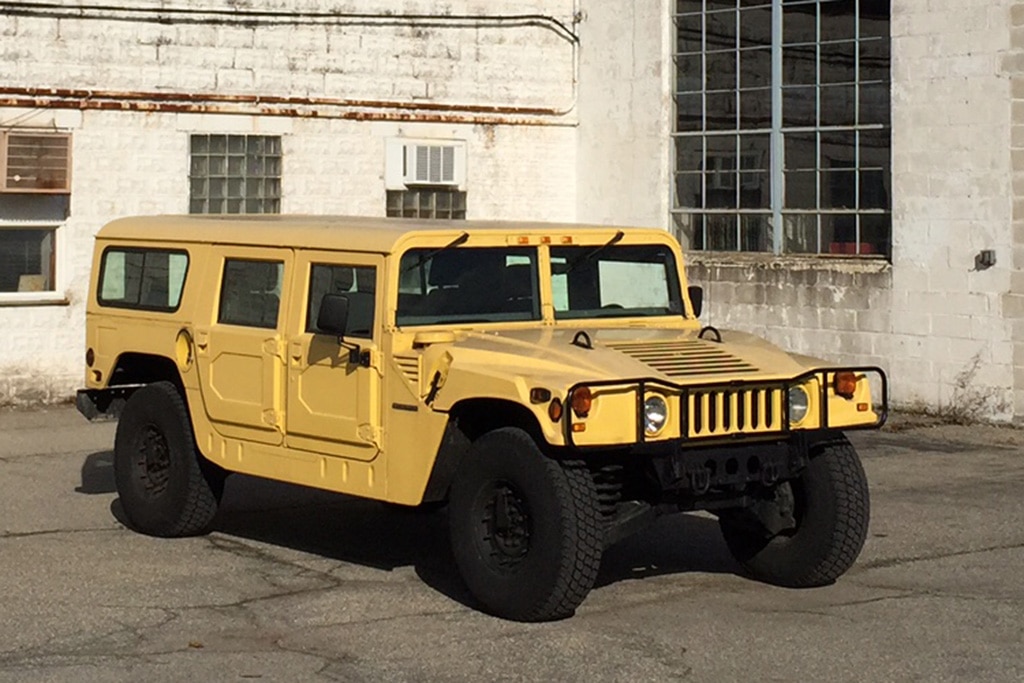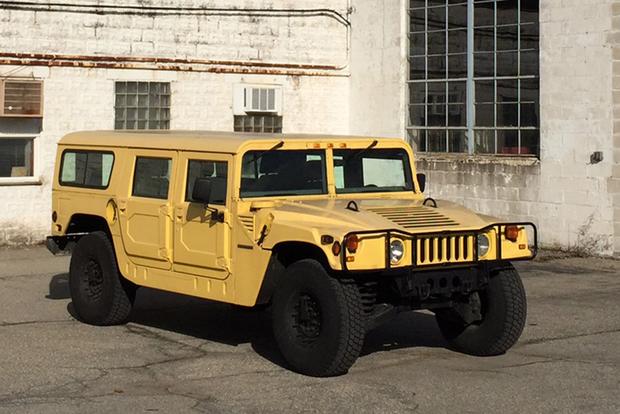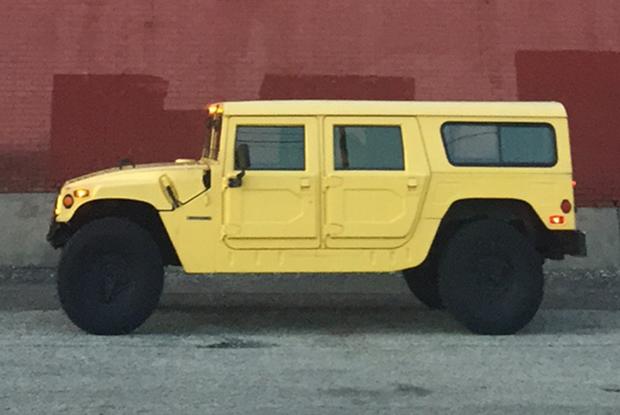The AM General HUMMER, known later as the H1 or the HMCS, is one of the toughest, most brawny, most crazily capable SUVs in the world. And that’s no surprise given that the impressive truck was developed for use by the United States military, then adapted for civilian life in the early 1990s thanks to several interested buyers, including legendary actor Arnold Schwarzenegger.
Called the HMMWV in the military (an acronym for High Mobility Multi-Purpose Wheeled Vehicle), the nickname Humvee was initially given to the giant vehicle. Eventually, soldiers and members of the public further nicknamed it the HUMMER. As a result, when it went on sale to civilians in 1992, it was officially called the AM General HUMMER. While the lineup eventually spawned smaller versions called the H2 and H3, it’s the original we’re covering today: the full-size, no-holds-barred H1.
What should you look for if you’re interested in buying one? I spent months looking for the right truck before I finally signed the papers on a 1995 model. Now I’ll cover everything you should know about choosing the right vehicle.
The HUMMER Body Styles
The HUMMER was manufactured in three different varieties by AM General, a heavy truck manufacturer located in South Bend, Indiana. The two most common varieties are the wagon, a 4-door model with a closed roof, much like a standard SUV, and the open-top or soft-top model, which has four doors, an open roof, and an open bed. There was also a 2-door pickup version with an enclosed roof, a single cab, and a large bed, though pickup versions are unusual in civilian (non-military) guise.
A fourth body style, dubbed the Slantback, was also available in extremely limited quantities for the civilian market. It was so limited, in fact, that it’s unlikely you’ll ever find one for sale. Slantback models featured a slanted cover over the cargo area, much like military versions. While some Slantback conversions exist, we suggest you pour some water on them before purchasing. AM General had considerable trouble waterproofing the Slantback rear end, and we suspect any aftermarket conversions will encounter similar problems.
Yearly Changes
The AM General HUMMER originally went on sale in civilian form for the 1992 model year, using a naturally-aspirated diesel engine. At the time, diesel power wasn’t as common as it is now, and many drivers wanted a gasoline option, so AM General added a gas-powered 5.7-liter V8 to the fold in 1994. Both the gas-powered version (like mine) and the naturally aspirated diesel are notoriously slow; neither offers more than 200 horsepower, and even the high torque figures weren’t enough to counteract the enormous curb weight.
Beginning with the 1996 model year, AM General dropped both the diesel and the gasoline engines and went with a new turbodiesel engine that offered more power and more torque. And then, for the next nine years, the vehicle was slowly improved: Climate control was enhanced for the 1997.5 model year, while anti-lock brakes were added in 1998. The interior grew nicer throughout the years, and wheel designs became more civilian friendly. The color palette expanded, and the cabin added even more features and equipment.
The last year of the regular turbodiesel was 2004. AM General skipped the 2005 model year, returning in 2006 with the last hurrah: the HUMMER H1 Alpha, which is the ultimate iteration of the truck. It boasted a new Duramax diesel engine with more torque and power, a further improved interior, stronger off-road capabilities, and many more upgrades. This is considered the ultimate iteration of the HUMMER, and the desirability for these upgrades is reflected in the prices of used Alpha models: They often trade hands for $100,000 or more, even 10 years after production ended.
The Trouble Spots
There’s no doubt about the HUMMER’s biggest trouble spot: the turbodiesel engines installed in all trucks made from 1996 to the middle of the 2000 model year. These engines are notorious for the number eight cylinder failure, which involves the truck’s eighth cylinder cracking due to a casting flaw. Many of these engines have been replaced by now, but you’ll want to have an inspection done on any vehicle made during those years to ensure that the replacement engine was fitted properly and that the original defective engine wasn’t replaced with a second defective engine.
Although it isn’t set in stone, there are two ways to determine if the truck you’re interested in may be on the hook for a cracked block. The general feeling among HUMMER enthusiasts is that trucks made after VIN number 188469 (the final six digits of the VIN) are OK, while those before are at risk. But the only surefire way to know is to get the casting number off the engine block and check to see if the engine was made after March 15, 1999. That date is indicated by the engine code C (denoting March as the third month) and 159 (15 denoting the date of manufacture and 9 representing the year 1999). An engine with a D-019 (April 1, 1999) code would be OK, for instance, as would A-150 (January 15, 2000).
Unfortunately, issues with the trucks don’t stop there. Some owners even refer to their trucks as High Mobility Money Wasting Vehicles, pursuant to the truck’s old HMMWV acronym, so you’ll want to watch for a few key issues. Be sure to check the central tire inflation system, which can add or remove air from the tires. While the system often works, it’s known for leaking. You may want to plug it rather than attempt to fix it. Otherwise, you might end up chasing leaks throughout the entire time you own the truck.
You’ll also want to check for engine leaks, underbody rust, and issues with the steering and the transfer case. Transfer case issues could require an entirely new transfer case, which is a costly repair, while steering issues may necessitate the replacement of the truck’s idler and pitman arms. That’s also not a cheap fix.
Get an Inspection
As you may have guessed from our write-up above, a poorly maintained HUMMER can suffer from some serious issues. While nothing is especially expensive to fix, these are complicated trucks with many unique parts. Some jobs are labor-intensive, and parts can be pricey. Worse, some parts are in short supply, so it might take days to get the right part you need for your truck to get back on the road. As a result, we strongly suggest getting a mechanical inspection before you buy.
I ordered three different inspections before purchasing my truck, and two came back with bad results. One truck, which looked especially nice on the outside, needed more than $10,000 in work to get back into nice shape. In the end, I chose a truck with a lot of cosmetic blemishes but a good mechanical bill of health. I didn’t want to deal with all the pitfalls and issues of owning a truck that’s had years of deferred maintenance.
Enjoy Your HUMMER
Once you’ve submitted your potential truck to a mechanical inspection, negotiated a good price, and signed the papers, we implore you to go out and enjoy your HUMMER. Although these can be finicky, difficult trucks, few things are more enjoyable than driving off-road in one. They’re more capable than practically everything else in the world. Find a HUMMER H1 for sale















More developenent nessecary regarding “poorly maintained Hummer.”
please, my marriage is on the line.
also, whats a “properly maintained” 1-Series M look like in these latter days, you fn fm!
Hey it’s Doug!! Love your channel!
Looking at my first hummer. its a 1990 with 30k on it. Going to look at it Thursday with a buddy thats in the Army and know much about them, but looking for a few other tips. Any help would be greatly appreciated. Thanks
I have 2 that I am probably getting ready to sell. One is a 1987 slant back, and one is a 86 pickup style. The 87 slantback runs, but needs a transmission. The 87 currently won’t start. It will turn over, just won’t fire. Debating selling them as is or fixing them and then selling. Any idea on what I should ask for them either way?
This is very helpful information on what to look for when researching on buying a used Hummer. Thanks…
Just getting into my search for my first Hummer…anyone selling? Any good deals to point me to? Thank you!
If you haven’t looked https://www.govplanet.com
looking at a 94 – 4 door with the 6.5. Soft top . It has 7800 miles on it and I’d like to run it 15K miles a year. Is that a crazy notion? I have a h3T alpa now with125K and no major problems. Are the older trucks as well built?
Hi my question is I can registration in New York City my humvee?
I don’t know if its a legit question or not, but can we put some other truck’s engine in hummvee? Like Chevy, Toyota or Cadilac (SUV’s only)?
maybe a tata’s or a lowry’s
Yes you can. I wouldn’t recommend changing manufacturers, but any GM engine can be installed easily. Just take the donors engine harness, and computer, and install them with the new motor. They will bolt right up to the existing transmission. I’d recommend using a Dumamax, like the last generation did. They have tons of power, and excellent reliability.
Question? You mentioned:
Now, I’ve heard of casting flaws in certain engine runs before, so this problem didn’t surprise me too much. But check this out: it affected every single Hummer manufactured from 1996 to 2000. Not a few. Not a portion. Not some, not half, not most. All. Every single Hummer built from 1996 to 2000 has either had its engine fail due to the number eight cylinder issue, or will have its engine fail due to the issue.
What about pre 1996 models? For example a 1993 with a VIN of 145679?
Should this be safe?
Please advise.
Thank you!
Anything with a non-turbo 6.5 is certainly safe. I am still running the 6.2 in my 87. Not fast, but I’ve also had Jeeps with 60 hp,so…